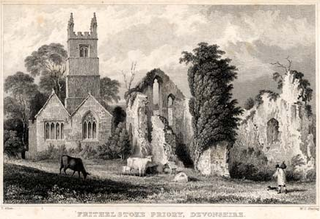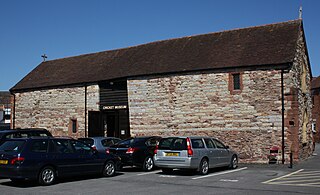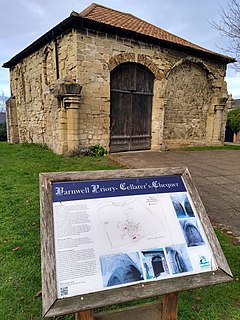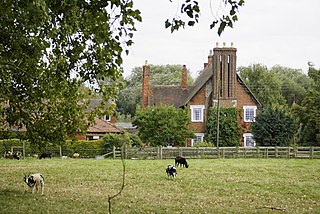Related Research Articles

Frithelstock Priory was founded in about 1220 at Frithelstock, Devon, England, by Sir Robert de Beauchamp for Augustinian Canons Regular, as an indulgence to ensure intercessions for the repose of his soul. Walter de Stapledon, Bishop of Exeter, is considered a co-founder, for increasing the priory's endowments.

Plympton is a suburb of the city of Plymouth in Devon, England. It is in origin an ancient stannary town. It was an important trading centre for locally mined tin, and a seaport before the River Plym silted up and trade moved down river to Plymouth and was the seat of Plympton Priory the most significant local landholder for many centuries.

Merton Priory was an English Augustinian priory founded in 1114 by Gilbert Norman, Sheriff of Surrey under King Henry I (1100-1135). It was situated within the manor of Merton in the county of Surrey, in what is today the Colliers Wood area in the London Borough of Merton.

Canonsleigh Abbey was an Augustinian priory in the parish of Burlescombe, Devon.
William Warelwast was a medieval Norman cleric and Bishop of Exeter in England. Warelwast was a native of Normandy, but little is known about his background before 1087, when he appears as a royal clerk for King William II. Most of his royal service to William was as a diplomatic envoy, as he was heavily involved in the king's dispute with Anselm, the Archbishop of Canterbury, which constituted the English theatre of the Investiture Controversy. He went several times to Rome as an emissary to the papacy on business related to Anselm, one of whose supporters, the medieval chronicler Eadmer, alleged that Warelwast bribed the pope and the papal officials to secure favourable outcomes for King William.
Events from the 1120s in England.

Taunton Priory, or the Priory of St Peter and St Paul, was an Augustinian house of canons founded c. 1115 by William Gyffarde, Bishop of Winchester and Chancellor of England near Taunton, Somerset, England.

St Anthony in Roseland is a village and a former parish in Cornwall, England, in the United Kingdom. It is a small settlement on the Roseland Peninsula.

Barnwell Priory was an Augustinian priory at Barnwell in Cambridgeshire, founded as a house of Canons Regular. The only surviving parts are 13th-century claustral building, which is a Grade II* listed, and remnants found in the walls, cellar and gardens of Abbey House.
The Priory of St Mary, Huntingdon was an Augustinian Priory in Huntingdonshire, England.
Launceston Priory was a priory at Newport, Launceston, Cornwall, England, UK.

Lammana Priory was a priory on Looe Island in Cornwall, UK, consisting of two Benedictine monks until 1289. It was owned by Glastonbury Abbey and the property was sold in 1289 to a local landowner.

Various monasteries and other religious houses have existed at various times during the Middle Ages in the city of Exeter, Devon, England.

Nocton Park Priory was an Augustinian priory in Nocton, Lincolnshire, England.
Priory of St. Thomas near Stafford was an Augustinian religious house near Stafford, Staffordshire, England. Founded sometime in approximately 1174, it was a surrendered to the Crown in 1538, during the Dissolution of the Monasteries.
Trentham Priory was a Christian priory in North Staffordshire, England, near the confluence between the young River Trent and two local streams, where the Trentham Estate is today.

Studley Priory, Warwickshire, was a priory in Studley, Warwickshire, England.
Robert was the Archdeacon of Totnes before 1184. He was the second son of Gille, or Egidia, of Salisbury and he appeared as Robert fitzGille in at least one document of Bartholomew Iscanus. His second brother was John of Salisbury. Robert and his younger brothers were close, and Robert even seems at some point to have bailed Richard out of trouble. Despite being a canon of Exeter, and therefore bound by clerical celibacy, Robert was married and had a son. He was also styled 'magister' and described as a physician: he left all his medical books to Plympton Priory, whither he retired sometime before his death in 1186.

Canonteign is an historic tything in the parish of Christow, near Chudleigh, in South Devon, England and situated in the valley of the River Teign. The 'canon' in the name refers to the Augustinian canons regular, either of St Mary du Val in Normandy or of Merton Priory, which owned it for several centuries. It is best known today for the Canonteign Falls waterfall. Canonteign today contains three significant houses: the original Grade I listed 16th-century manor house, the ancient barton house situated nearby behind a granite wall, and a new mansion house built by the Pellew family in the early 19th century nearby, to which that family moved their residence thereby abandoning the old manor house.
References
- ↑ A.D. Fizzard, Plympton Priory, A House of Augustinian Canons in South-Western England in the Late Middle Ages, 2007.
- ↑ D.E. Kennedy, Annals of Plympton, in G. Dunphy, Encyclopedia of the Medieval Chronicle, 2011.
- ↑ C.A.T.Butterill, The Foundations of Augustinian Priories in England During the Reign of Henry I, 1100-1135 (PhD. Thesis: University of London, 1999), p.95; Fizzard, op.cit., p.27.
- ↑ https://actswilliam2henry1.files.wordpress.com/2018/05/h1-plympton-priory-2018-1.pdf, p.12.
- ↑ Fizzard, op.cit., p.33.
- ↑ Lionel Green, Daughter Houses of Merton Priory, p.10
- ↑ "Plympton Priory, non Civil Parish - 1017594 | Historic England".
- ↑ Fizzard, op.cit., p.57; Sir John Maclean, The Parochial and Family History of the Deanery of Trigg Minor, Volume 2, p.89.
Coordinates: 50°23′14″N4°03′29″W / 50.387169°N 4.058161°W